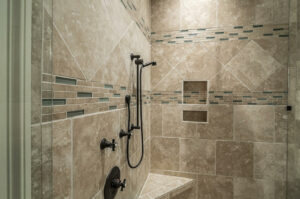Our bathrooms, especially shower areas, are extremely moisture-rich areas, which is why their maintenance tends to differ from all other types of tiles in the house. Typically, shower tiles require to be sealed because they contain grout, which is an extremely porous material. To avoid moisture build-up in the grout and tiles, it is always recommended to seal your shower tiles.
This guide will explain how to seal shower tiles, why it is necessary, and which types of shower tiles don’t require sealing.

Why We Should Seal Grout in Shower Tiles
When the grout in tiles is not properly sealed, it can absorb moisture from the environment and damage the finish on the tiles. It can also lead to the development of mildew and mold. In the end, you will likely have to replace your tiles. Hence, to save yourself from such a costly job and extra effort, it’s best if you seal the grout in your shower tile.
All of this is especially true for shower tiles because they are exposed to the most moisture compared to other parts of the bathroom. By sealing shower tile grout, you will be blocking the moisture from being absorbed by the grout, making this an absolutely essential step in maintaining your tiles.
Which Shower Tiles Don’t Need to Be Sealed
There are some exceptions to the rule depending on the type of tiles in your bathroom. That is, some tiles require sealant while others don’t. For example, ceramic and porcelain bathroom tiles don’t necessarily require sealing, at least not in the beginning when you install them. This is because they already come with a water-resistant glossy surface, and so provides protection from moisture.
On the other hand, natural stone tiles, such as those made of limestone, require sealing because they are quite absorbent. If you don’t seal them, they will absorb moisture.
How to Seal Shower Tiles
If your shower tiles are made of natural stone or ceramic, or porcelain but not new, you need to seal them. Sealing shower tile grout is a relatively straightforward and easy job. There are three methods you can choose from. They include the following:
Brush On
This type of sealer is milky in texture and requires a brush tip to apply. However, while applying, make sure the sealant does not get on the tiles.
Roller
This is an excellent application method because it ensures that you don’t miss a spot in the grout line. You will also need very rare touch-ups when you apply sealant this way.
Spray-On
This is the easiest application method, though it might not be the most effective. This is because you will need frequent touch-ups with it.
Final Words
Sealing shower tile grout is an essential step for every type of shower tile because it ensures its longevity. Moreover, applying sealant is an easy and quick process. If you require any assistance with your tile management, don’t hesitate to get in touch with one of the best sealing experts in the country, Grout Magnificent. Book a free consultation with them today!
